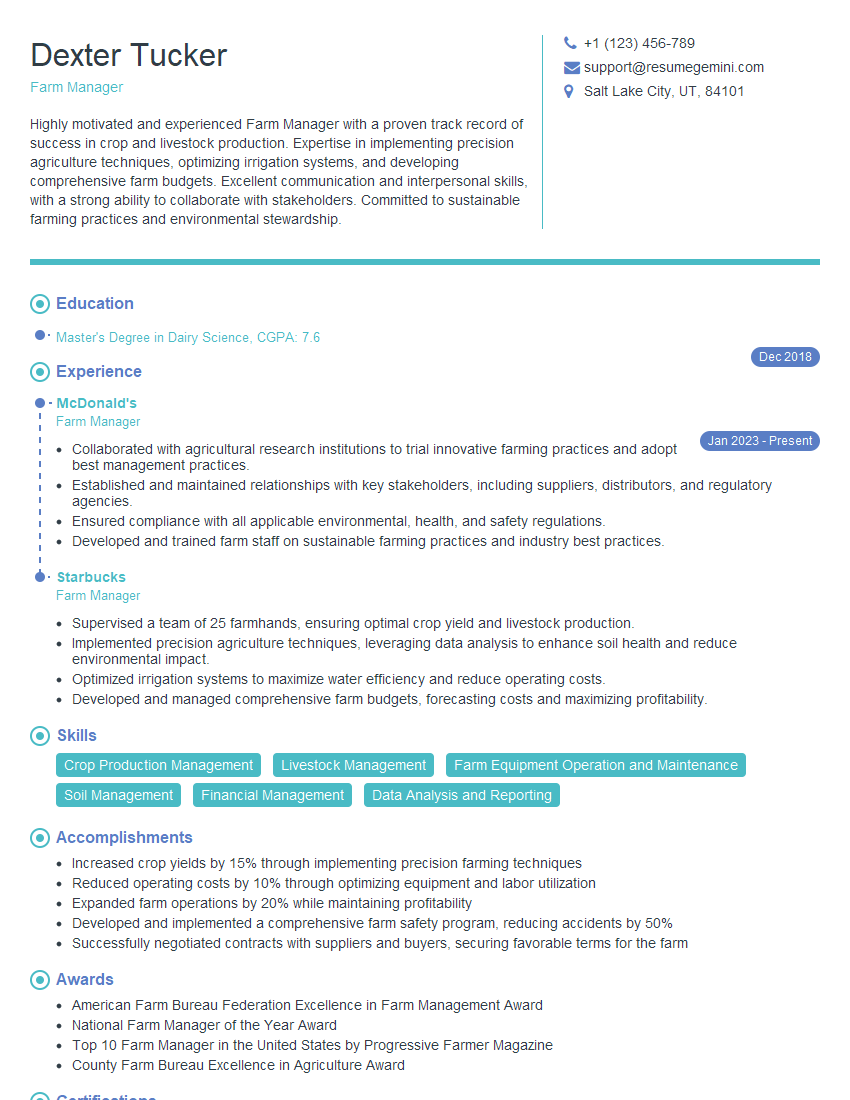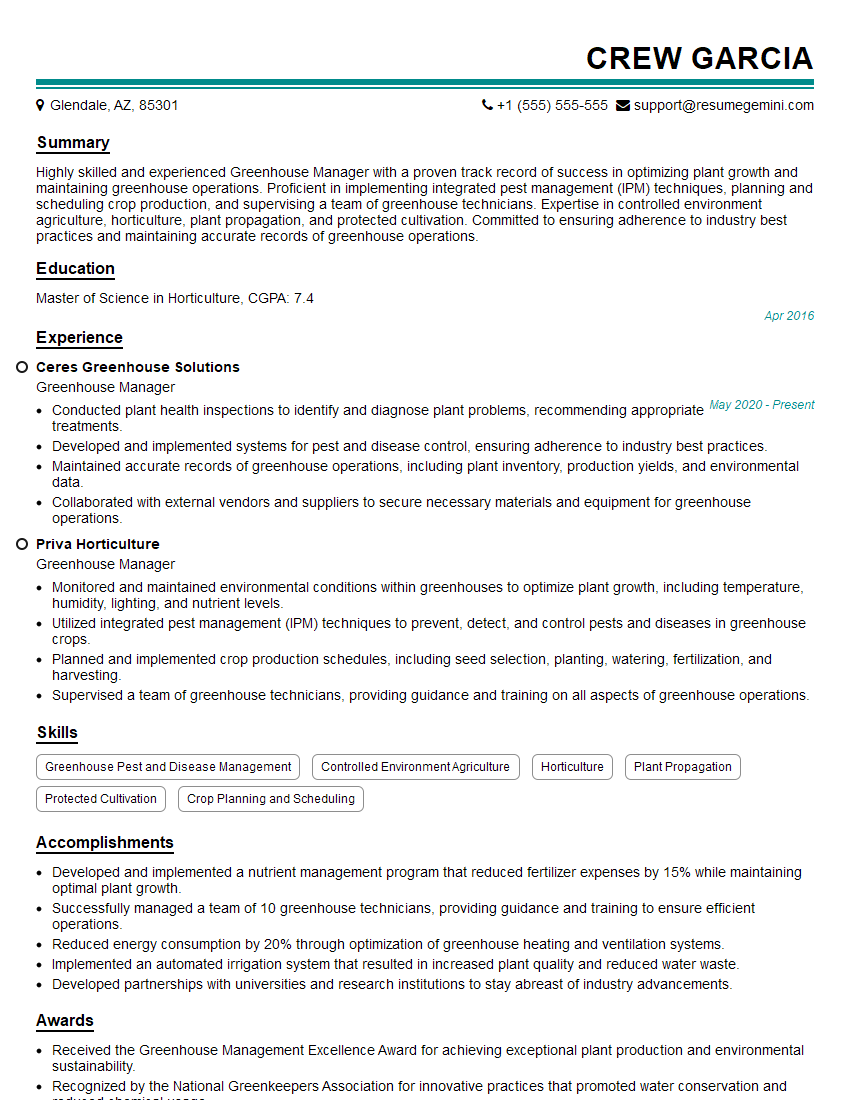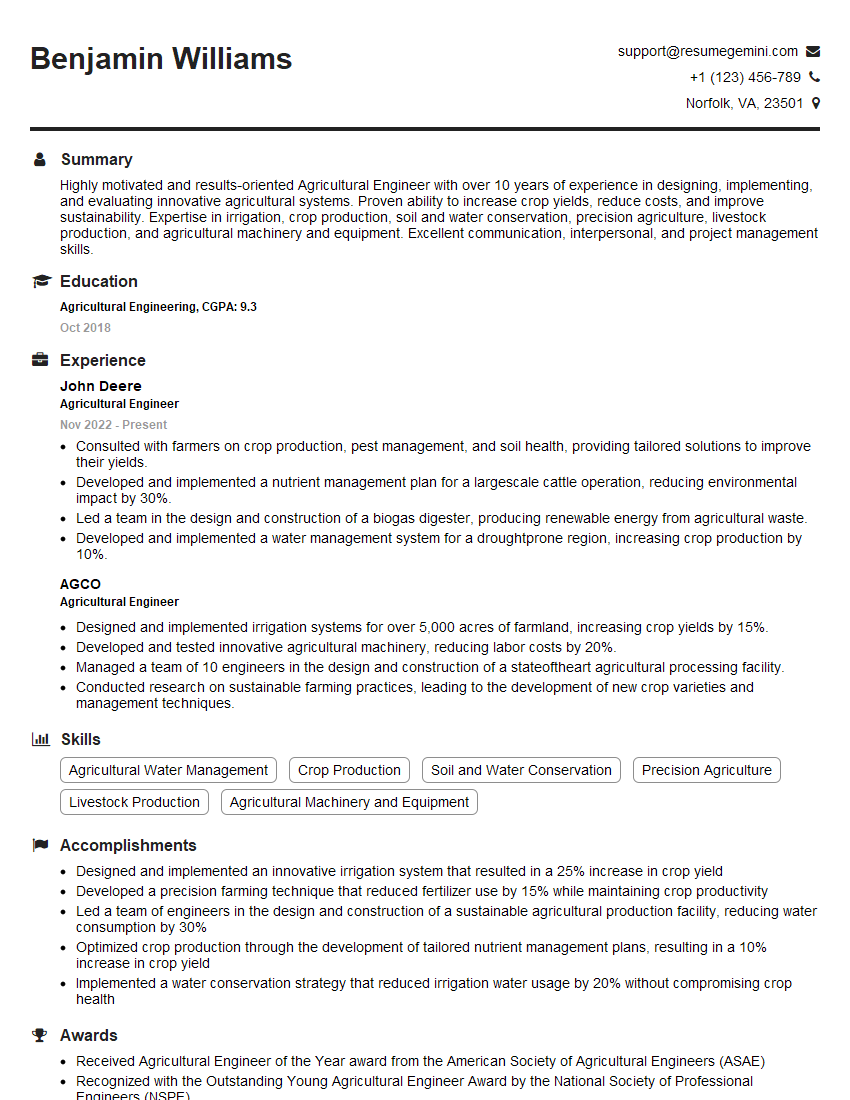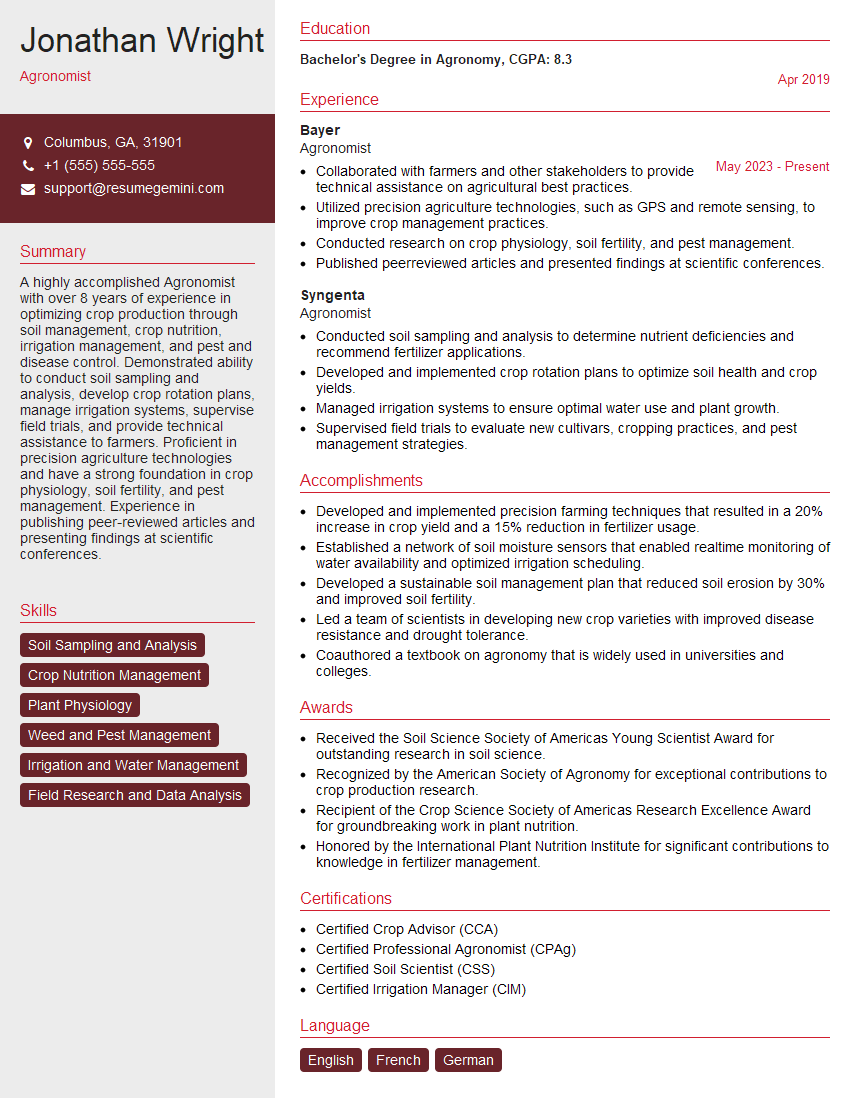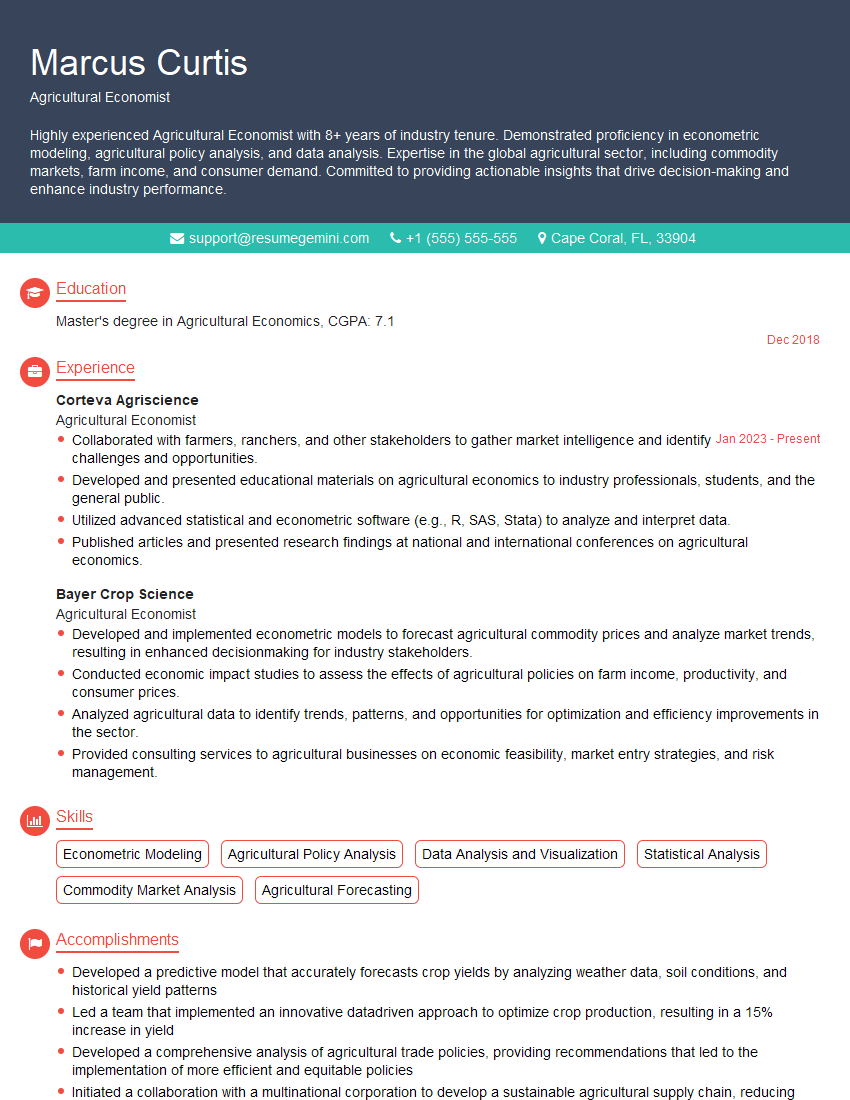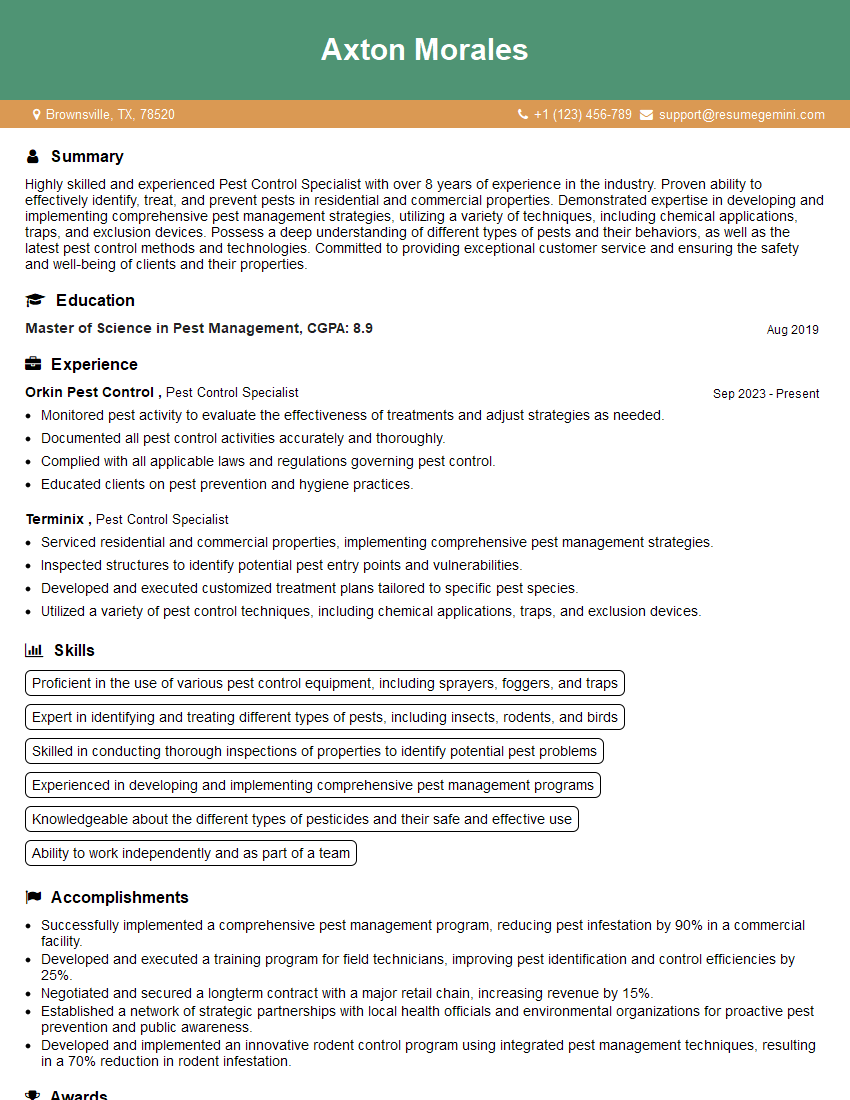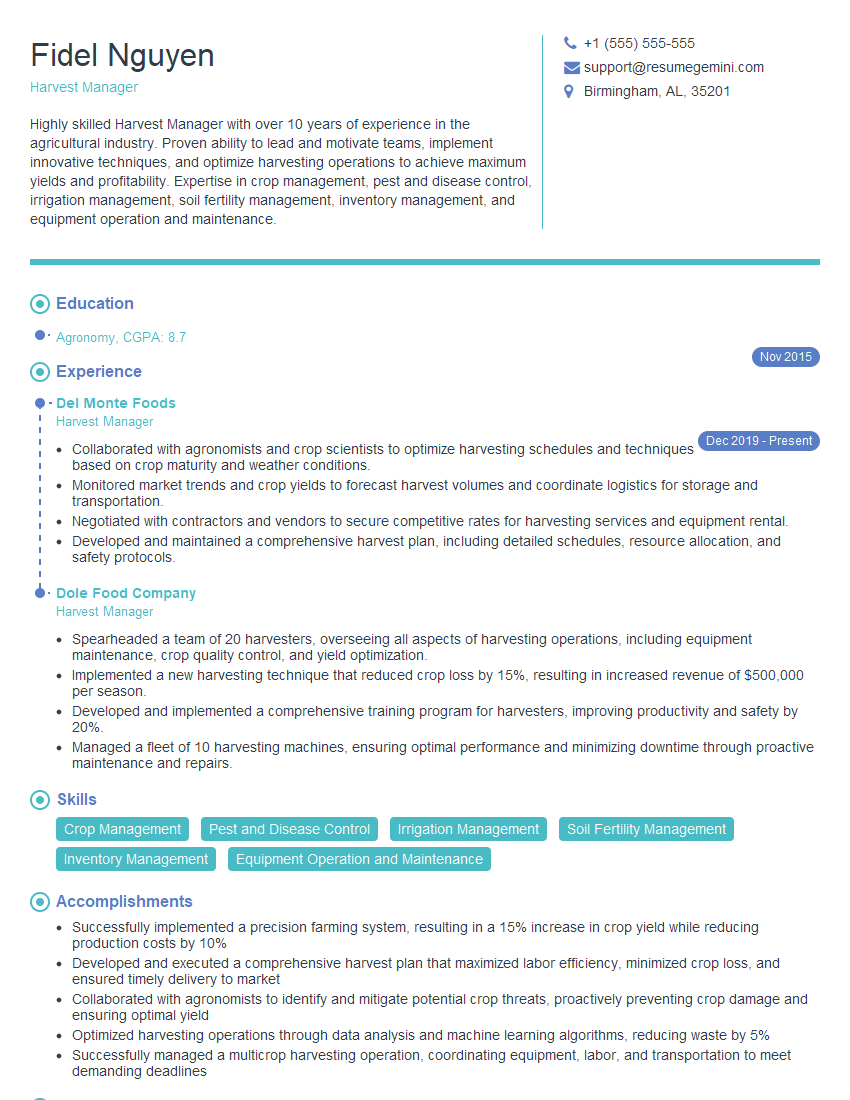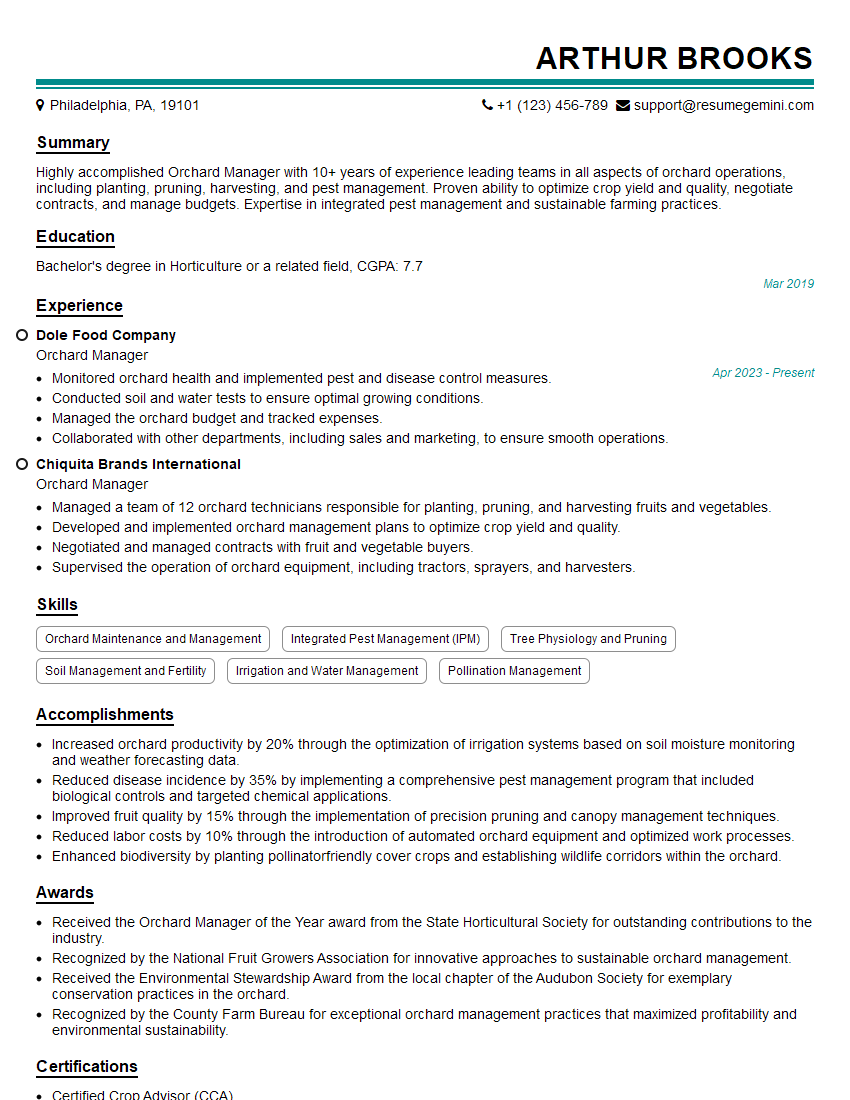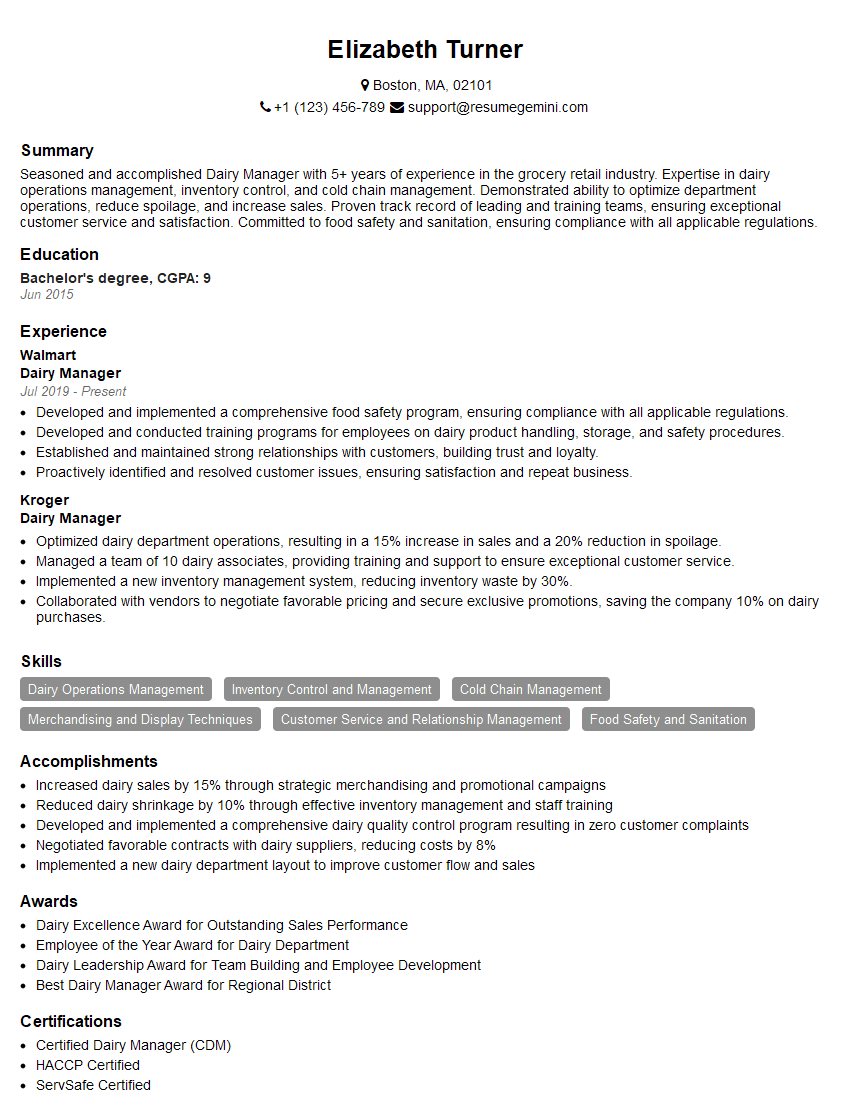Feeling uncertain about what to expect in your upcoming interview? We’ve got you covered! This blog highlights the most important Knowledge of Agricultural Production and Processing interview questions and provides actionable advice to help you stand out as the ideal candidate. Let’s pave the way for your success.
Questions Asked in Knowledge of Agricultural Production and Processing Interview
Q 1. Describe your experience with different irrigation techniques.
Irrigation is the artificial application of water to land to assist in the production of crops. My experience encompasses a wide range of techniques, each suited to different climates, soil types, and crop needs.
- Flood Irrigation: This traditional method involves flooding a field with water. While simple and cost-effective, it’s inefficient, leading to significant water waste and potential soil erosion. I’ve used this method in level fields with low water costs, but recognize its limitations.
- Furrow Irrigation: Water flows through furrows (channels) between crop rows. It’s more efficient than flooding but still prone to runoff and uneven water distribution. I’ve found it suitable for crops like potatoes and certain vegetables on gently sloping land.
- Drip Irrigation: A highly efficient method delivering water directly to plant roots through a network of pipes and emitters. This minimizes water waste, improves water use efficiency, and reduces weed growth. I’ve extensively used drip irrigation in orchards and vineyards, seeing significant improvements in yield and quality.
- Sprinkler Irrigation: Water is sprayed onto the field through sprinklers. It’s versatile and adaptable to various terrains, but it can be less efficient than drip irrigation due to evaporation and wind drift. I’ve used this method in areas with sandy soils where drip irrigation might not be as effective.
- Subsurface Irrigation: Water is applied beneath the soil surface, minimizing evaporation and improving soil moisture consistency. This is very efficient but requires careful planning and installation and is more expensive upfront. It’s best suited for specific soil types and crops.
Choosing the right irrigation technique involves careful consideration of factors like water availability, topography, soil type, crop requirements, and budget. My expertise lies in optimizing irrigation strategies for maximum efficiency and minimizing environmental impact.
Q 2. Explain the principles of crop rotation and its benefits.
Crop rotation is the practice of planting different types of crops in a planned sequence on the same piece of land over several growing seasons. It’s a fundamental principle of sustainable agriculture.
Principles: The key is to strategically alternate crops with different nutrient needs and pest/disease susceptibilities. For example, a legume (like beans or clover) fixing nitrogen in the soil might be followed by a heavy feeder like corn.
- Nutrient Management: Different crops extract different nutrients from the soil. Rotation helps prevent depletion of specific nutrients. Legumes, for instance, enrich the soil with nitrogen, reducing the need for nitrogen fertilizers in subsequent crops.
- Pest and Disease Control: Rotating crops disrupts the life cycles of many pests and diseases, reducing their populations and minimizing crop damage. A pest that thrives on corn will find itself starved if corn is not planted in the following season.
- Weed Control: Certain rotations can suppress weed growth. For example, cover crops can smother weeds, reducing the need for herbicides.
- Soil Health Improvement: Crop rotation improves soil structure, water infiltration, and overall soil health by introducing diverse root systems. Deep-rooted crops improve drainage while shallow-rooted crops aid in surface soil structure.
Benefits: The benefits are numerous: reduced pesticide use, enhanced soil fertility, improved water use efficiency, increased crop yields, and enhanced overall farm sustainability. In my experience, implementing effective crop rotation plans has been crucial for achieving long-term profitability and environmental responsibility on farms.
Q 3. What are the key factors affecting soil fertility?
Soil fertility refers to the ability of soil to support plant growth. Many factors influence this crucial aspect of agriculture:
- Organic Matter Content: High organic matter levels improve soil structure, water retention, and nutrient availability. Decomposing organic matter releases nutrients slowly, providing a steady supply for plants. This is one of the most important things to manage.
- Nutrient Levels: Essential nutrients like nitrogen (N), phosphorus (P), potassium (K), and micronutrients (e.g., iron, zinc) are vital for plant growth. Soil testing is crucial to determine nutrient deficiencies and guide fertilization strategies.
- Soil pH: The soil’s acidity or alkalinity influences nutrient availability. Most plants thrive within a specific pH range. Lime can be used to increase pH (reduce acidity) and sulfur can be used to decrease pH (increase acidity).
- Soil Texture and Structure: Soil texture (sand, silt, clay content) affects water retention, aeration, and root penetration. Good soil structure with aggregates allows for healthy root growth and water movement. Improving soil structure can involve cover cropping and the addition of compost.
- Soil Biology: A diverse and healthy soil ecosystem with beneficial microorganisms plays a vital role in nutrient cycling and disease suppression. Healthy soil is teeming with life!
- Climate and Weather: Rainfall, temperature, and other weather patterns influence nutrient availability and plant growth. Drought can stress plants and reduce nutrient uptake.
Managing soil fertility involves a holistic approach encompassing soil testing, balanced fertilization, organic matter incorporation, and other sustainable soil management practices. I always emphasize building soil health as the foundation for successful and sustainable agriculture.
Q 4. How do you manage pest and disease control in agricultural production?
Pest and disease control is crucial for maximizing crop yields and ensuring food safety. My approach is integrated pest management (IPM), a holistic strategy that combines various methods to minimize pest and disease impact.
- Cultural Practices: These include crop rotation, resistant varieties, proper planting density, and sanitation to minimize pest and disease establishment. Rotating crops reduces pest pressure significantly.
- Biological Control: Introducing natural enemies like beneficial insects or nematodes to control pests. This is an environmentally friendly way to control pest populations.
- Chemical Control: Using pesticides only when necessary and following label instructions meticulously. This should be a last resort and employed only when economic thresholds are exceeded, and other methods are insufficient.
- Monitoring and Surveillance: Regularly inspecting crops to detect pest and disease outbreaks early. Early detection is key to effective and timely intervention.
- Record Keeping: Maintaining detailed records of pest and disease occurrences, treatment strategies, and their effectiveness to inform future decision-making.
IPM is crucial because it reduces reliance on potentially harmful chemicals, preserving beneficial organisms and minimizing environmental impact. My experience shows that a well-planned IPM strategy consistently provides effective and sustainable pest and disease control.
Q 5. Describe your experience with different harvesting methods.
Harvesting methods vary greatly depending on the crop type and scale of production.
- Manual Harvesting: Picking crops by hand. This is labor-intensive but often necessary for delicate fruits and vegetables where machine harvesting could cause damage. I’ve used this extensively for high-value crops like strawberries and certain specialty vegetables.
- Mechanical Harvesting: Utilizing machinery to harvest crops. This is efficient for large-scale production but requires specialized equipment and is not suitable for all crops. Combines are commonly used for grains, and mechanical harvesters exist for many other crops like potatoes and tomatoes.
- Selective Harvesting: Harvesting only mature or high-quality produce, leaving immature or damaged items in the field. This increases the quality and value of the harvest. This is often combined with hand or mechanical harvesting.
The choice of harvesting method is based on factors such as the crop’s characteristics, the scale of production, available labor, and economic considerations. The goal is to harvest the crop efficiently while minimizing damage and maximizing quality.
Q 6. What are the common post-harvest handling practices for [specific crop]?
Let’s assume the specific crop is tomatoes. Post-harvest handling of tomatoes is crucial for maintaining quality and extending shelf life.
- Careful Harvesting: Avoid bruising during picking. Use appropriate containers and handling techniques.
- Cleaning and Sorting: Remove damaged or diseased fruits. Sort tomatoes by size and quality.
- Pre-cooling: Rapidly cooling tomatoes after harvest slows down ripening and reduces microbial growth. Hydrocooling or forced-air cooling are commonly used.
- Packaging: Use appropriate packaging materials to protect tomatoes from bruising and maintain freshness. Packaging choice depends on the transportation method and intended market.
- Storage: Store tomatoes at optimal temperature and humidity to prevent spoilage. The ideal temperature depends on the intended shelf life; short-term storage might use room temperature, while longer storage utilizes cooler temperatures.
- Transportation: Handle tomatoes carefully during transportation to avoid damage. Maintain cool temperatures throughout transportation.
Proper post-harvest handling is vital for minimizing losses and maintaining the quality and marketability of the tomatoes. Every step, from harvest to delivery, needs attention to detail.
Q 7. Explain the importance of quality control in agricultural processing.
Quality control (QC) in agricultural processing ensures that products meet specific standards for safety, quality, and consistency. This is vital for consumer protection, market competitiveness, and maintaining a positive brand reputation.
- Raw Material Inspection: Inspecting incoming raw materials to ensure they meet the required quality standards. This includes checking for defects, contamination, and adherence to specifications.
- Process Monitoring: Regularly monitoring processing parameters such as temperature, time, and pressure to ensure consistent product quality. This might involve using sensors, automated systems, and regular checks by personnel.
- Product Testing: Conducting various tests to assess the quality of the finished product. These tests can include microbial analysis, sensory evaluation, chemical analysis, and physical property measurements.
- Packaging Inspection: Checking packaging integrity, labeling accuracy, and overall presentation. This helps maintain product quality and meets regulatory requirements.
- Traceability Systems: Implementing traceability systems to track products through all stages of the production process. This helps in identifying the source of any quality issues.
Effective QC involves a multi-faceted approach, combining proper hygiene, standardized procedures, and diligent monitoring. It’s an ongoing process that ensures consistent high quality and strengthens customer trust.
Q 8. What are the different methods of food preservation?
Food preservation aims to extend the shelf life of food products by preventing spoilage and microbial growth. Various methods achieve this, categorized broadly into physical, chemical, and biological techniques.
- Physical Methods: These methods involve altering the food’s environment to inhibit microbial growth. Examples include:
- Refrigeration and Freezing: Slowing down microbial activity by lowering temperatures. Think of keeping milk cold or freezing berries for later use.
- Drying/Dehydration: Removing moisture, making the environment unsuitable for microbial growth. Sun-dried tomatoes or jerky are classic examples.
- Heating (Pasteurization & Canning): Using heat to kill microorganisms. Pasteurization gently heats milk to kill harmful bacteria, while canning uses high heat to sterilize food and seal it in airtight containers.
- Irradiation: Exposing food to ionizing radiation to kill microorganisms. Used for extending the shelf life of certain spices and fruits.
- Chemical Methods: These involve adding substances to inhibit microbial growth or slow down enzymatic reactions causing spoilage. Examples include:
- Salting, Sugaring, Smoking: These methods reduce water activity, hindering microbial growth. Think of pickled cucumbers or smoked salmon.
- Chemical preservatives: Substances like sodium benzoate or sorbic acid are added to prevent microbial growth in foods like jams and processed meats.
- Biological Methods: These methods leverage the actions of microorganisms to preserve food. An example is:
- Fermentation: Utilizing beneficial microorganisms to produce lactic acid or other antimicrobial compounds, preserving the food while adding flavor. Examples include sauerkraut, yogurt, and kimchi.
The choice of preservation method depends on several factors including the type of food, desired shelf life, cost, and consumer preferences.
Q 9. How do you ensure food safety throughout the production and processing chain?
Ensuring food safety requires a comprehensive approach throughout the entire production and processing chain, adhering to stringent hygiene and quality control measures at each stage. This involves implementing a robust Hazard Analysis and Critical Control Points (HACCP) system.
Key aspects include:
- Good Agricultural Practices (GAPs): Implementing sanitary practices during crop production, minimizing contamination from soil, water, and pests. This includes proper fertilizer and pesticide use, and effective irrigation management.
- Good Manufacturing Practices (GMPs): Maintaining a clean and sanitary processing environment, including proper hygiene for personnel, equipment sanitation, and pest control. This ensures that no contamination occurs during processing.
- Traceability: Establishing a system to track food products from origin to consumer. This allows for rapid identification and removal of contaminated products in case of an outbreak.
- Temperature Control: Maintaining appropriate temperatures throughout the production and processing chain, preventing the growth of harmful microorganisms. This involves utilizing refrigeration, freezing, and heating as needed.
- Proper Packaging: Selecting packaging materials that prevent contamination and maintain product quality and safety. This ensures the product remains safe and protected until consumption.
- Regular Monitoring and Testing: Conducting regular inspections and testing for pathogens and contaminants to detect and address potential hazards. This involves microbiological testing and chemical analysis.
A strong food safety culture, encompassing training and awareness among all personnel, is crucial for the successful implementation of these measures. Regular audits and continuous improvement are key to maintaining food safety standards.
Q 10. Describe your experience with different livestock management practices.
My experience encompasses a wide range of livestock management practices, from extensive grazing systems to intensive confinement operations. I’ve worked with various species including cattle, pigs, poultry, and sheep.
- Extensive Grazing: This involves managing livestock in large pastures with minimal human intervention. I’ve been involved in rotational grazing techniques, aiming to optimize pasture utilization and minimize environmental impact. This requires careful monitoring of pasture health and animal condition.
- Intensive Confinement: This involves raising animals in controlled environments, such as barns or sheds, with strict management of feed, water, and environmental conditions. My experience includes optimizing feed formulations, monitoring animal health, and implementing biosecurity measures to prevent disease outbreaks. This requires meticulous record-keeping and attention to detail.
- Integrated Systems: I’ve also worked in integrated systems that combine different livestock species or integrate livestock with crop production. This can improve resource utilization and reduce environmental impact. For example, integrating poultry with pig farming utilizes waste from one species to fertilize crops for the other, creating a closed-loop system.
Throughout my career, I’ve emphasized data-driven decision-making, using performance indicators to optimize productivity and animal welfare.
Q 11. What are the key factors affecting livestock productivity?
Livestock productivity is influenced by a complex interplay of factors, broadly categorized into genetic, nutritional, environmental, and health-related aspects.
- Genetics: Breed selection plays a crucial role. Choosing breeds adapted to the environment and with superior genetic traits for growth, milk production, or meat quality is essential.
- Nutrition: Providing a balanced diet that meets the animal’s nutritional requirements is critical. This involves formulating rations based on the animal’s stage of development and production level, using high-quality feedstuffs and ensuring access to clean water.
- Environment: Providing a comfortable and safe environment is vital. This involves managing temperature, humidity, ventilation, and light exposure, to minimize stress and optimize animal health and performance. Housing design also plays a crucial role, especially in intensive systems.
- Health: Implementing effective disease prevention and control programs is paramount. This involves vaccination, biosecurity measures to prevent disease introduction, and prompt treatment of sick animals. Regular health monitoring and parasite control are equally crucial.
- Management Practices: Efficient management practices are key. This includes proper breeding management, record-keeping, and the timely implementation of appropriate interventions. Proper handling and minimizing stress during various management activities are also important for productivity.
Optimizing livestock productivity requires a holistic approach, considering the interactions between these factors. Data-driven decision-making and continuous monitoring are essential for improvement.
Q 12. How do you manage animal health and welfare?
Managing animal health and welfare involves a multi-faceted approach focusing on preventative measures and prompt intervention when necessary.
- Preventative Measures: This includes vaccination programs tailored to the specific diseases prevalent in the area, regular parasite control, and biosecurity measures to prevent the introduction of pathogens. Providing a stress-free environment through appropriate housing, handling practices, and access to resources is also vital.
- Monitoring Animal Health: Regular health checks are necessary to identify sick or injured animals early on. This involves visual observation, weight monitoring, and potentially blood tests or other diagnostic tools. Early detection enables prompt treatment, reducing morbidity and mortality.
- Veterinary Care: Establishing a relationship with a qualified veterinarian is essential for advice on disease prevention and treatment. Prompt veterinary intervention is crucial in case of outbreaks or individual animal health issues.
- Record Keeping: Meticulous record-keeping is crucial for tracking animal health, treatment, and production data. This provides valuable information for future management decisions and helps identify potential issues early.
- Welfare Assessment: Regular welfare assessments ensure animals are meeting their five freedoms (freedom from hunger and thirst, freedom from discomfort, freedom from pain, injury or disease, freedom to express normal behavior, and freedom from fear and distress).
The emphasis is on creating a healthy and comfortable environment that allows animals to thrive and express their natural behaviors. This approach not only improves animal welfare but also positively impacts productivity and overall farm sustainability.
Q 13. Explain the principles of sustainable agricultural practices.
Sustainable agricultural practices aim to meet the present needs without compromising the ability of future generations to meet their own needs. It’s a holistic approach integrating economic, environmental, and social considerations.
- Soil Health: Maintaining and improving soil health is paramount, using practices like cover cropping, crop rotation, and reduced tillage to enhance soil fertility, water retention, and biodiversity. Minimizing soil erosion is also crucial.
- Water Management: Efficient and responsible water use is vital, employing techniques like drip irrigation, rainwater harvesting, and water-efficient cropping systems. Minimizing water pollution from agricultural runoff is also important.
- Biodiversity: Promoting biodiversity on farms is beneficial, including integrating trees and hedgerows, using pest-resistant crop varieties, and encouraging beneficial insects and pollinators. This builds resilience against pests and diseases.
- Nutrient Management: Utilizing nutrients efficiently is important, optimizing fertilizer application, utilizing organic fertilizers (compost, manure), and minimizing nutrient losses through improved management practices.
- Integrated Pest Management (IPM): Employing integrated pest management strategies minimizes the use of chemical pesticides, utilizing biological control, cultural practices, and chemical intervention only as a last resort.
- Climate Change Mitigation: Reducing greenhouse gas emissions from agriculture is essential through techniques like carbon sequestration in soils, reducing energy consumption, and improving livestock management practices.
Sustainable agriculture strives to create a resilient and productive farming system that benefits both the environment and society.
Q 14. What are the challenges of implementing sustainable agriculture?
Implementing sustainable agriculture faces numerous challenges:
- Economic Constraints: Transitioning to sustainable practices can involve higher upfront costs, potentially impacting profitability in the short term. Farmers may require financial incentives or support to adopt these practices.
- Technological Limitations: The availability and accessibility of suitable technologies for sustainable agriculture can vary significantly, depending on location and resources. Research and development are needed to improve the affordability and effectiveness of these technologies.
- Market Demand and Consumer Preferences: Consumer demand for sustainably produced food can influence the economic viability of sustainable agriculture. Increased consumer awareness and willingness to pay a premium for sustainable products are important drivers.
- Policy and Regulatory Frameworks: Supportive policies and regulations are crucial to incentivize the adoption of sustainable practices, creating a level playing field and discouraging unsustainable practices.
- Knowledge and Skills Gaps: Farmers require training and education to effectively adopt and implement sustainable practices. Extension services and capacity-building programs are needed to bridge knowledge gaps.
- Infrastructure Limitations: In some regions, inadequate infrastructure, such as irrigation systems or storage facilities, can limit the effective implementation of sustainable agricultural practices.
Addressing these challenges requires a collaborative approach involving farmers, researchers, policymakers, and consumers. Innovation, financial incentives, and supportive policies are key to accelerating the adoption of sustainable agriculture.
Q 15. Describe your experience with agricultural technology and automation.
My experience with agricultural technology and automation spans several years, encompassing both precision farming techniques and automated machinery. I’ve worked extensively with GPS-guided tractors and planters, which significantly improve planting accuracy and reduce seed waste. This is achieved through real-time data analysis, allowing for variable rate application of fertilizers and pesticides, optimizing resource utilization and minimizing environmental impact.
Furthermore, I’m proficient in using drones for crop monitoring. Drones equipped with multispectral cameras provide detailed imagery of crop health, allowing for early detection of disease, nutrient deficiencies, and stress factors. This enables timely interventions, leading to improved yields and reduced losses. I’ve also worked with automated irrigation systems, controlled by sensors that monitor soil moisture levels, ensuring crops receive the optimal amount of water, thus conserving water resources and improving efficiency.
For example, in one project, we implemented an automated harvesting system for a large-scale fruit orchard. This reduced labor costs by 40% while simultaneously improving the speed and quality of harvest. The integration of these technologies requires a strong understanding of both agricultural principles and data science, which I possess.
Career Expert Tips:
- Ace those interviews! Prepare effectively by reviewing the Top 50 Most Common Interview Questions on ResumeGemini.
- Navigate your job search with confidence! Explore a wide range of Career Tips on ResumeGemini. Learn about common challenges and recommendations to overcome them.
- Craft the perfect resume! Master the Art of Resume Writing with ResumeGemini’s guide. Showcase your unique qualifications and achievements effectively.
- Don’t miss out on holiday savings! Build your dream resume with ResumeGemini’s ATS optimized templates.
Q 16. How do you use data analysis to improve agricultural production?
Data analysis is crucial for optimizing agricultural production. I leverage various data sources, including sensor data from the field, weather forecasts, historical yield data, and soil analysis reports, to build predictive models. These models help anticipate potential problems and optimize resource allocation.
For instance, by analyzing historical yield data and weather patterns, I can predict the optimal planting time for specific crops, maximizing yields. Similarly, by analyzing soil sensor data, I can determine the precise nutrient needs of a crop, minimizing fertilizer waste and maximizing nutrient uptake. This precision approach minimizes the environmental footprint while maximizing profitability.
My analytical skills also extend to using statistical software and programming languages like R and Python to process and visualize large datasets. I’m familiar with various statistical techniques, such as regression analysis and time series analysis, to identify trends and patterns in the data. This enables me to make data-driven decisions that improve the efficiency and sustainability of agricultural operations. For example, I recently used a machine learning model to predict pest outbreaks, allowing for proactive intervention and preventing significant yield losses.
Q 17. What is your experience with agricultural economics and market trends?
My understanding of agricultural economics and market trends is grounded in years of experience analyzing market prices, production costs, and consumer demand. I use this knowledge to advise farmers on optimal planting decisions, pricing strategies, and risk management techniques.
I’m adept at forecasting commodity prices using various econometric models and considering factors such as global supply and demand, weather conditions, and government policies. For example, I helped a group of farmers make informed decisions about planting certain crops based on anticipated market prices, leading to increased profitability.
Understanding market trends also involves considering consumer preferences. Knowing what consumers want—organic produce, for example—allows farmers to tailor their production accordingly, enhancing their market position. I also stay abreast of current agricultural policies and regulations that impact production costs and market access. This holistic approach ensures profitable and sustainable agricultural practices.
Q 18. Describe your experience with agricultural supply chain management.
My experience in agricultural supply chain management encompasses all stages, from farm to consumer. I understand the complexities involved in getting produce from the field to the market efficiently and effectively.
This includes optimizing transportation logistics, ensuring proper storage and handling to maintain quality, and establishing relationships with buyers and distributors. I’ve worked on projects that have streamlined the entire process, minimizing waste, reducing costs, and improving product traceability. For example, I helped implement a cold chain management system for a perishable product, significantly reducing spoilage rates and increasing profits.
In addition, I have experience with inventory management, quality control, and risk management within the supply chain. By leveraging technology such as blockchain, we can enhance transparency and accountability, creating a more efficient and trustworthy system for all stakeholders.
Q 19. How do you manage risk in agricultural production?
Managing risk in agricultural production is paramount. It’s a multifaceted process that involves identifying potential threats, assessing their likelihood and impact, and developing mitigation strategies.
Some common risks include adverse weather events, pest infestations, price volatility, and disease outbreaks. I use a combination of approaches to mitigate these risks. This includes diversification of crops, utilizing crop insurance, implementing integrated pest management strategies, and employing precision agriculture techniques. Diversification, for instance, spreads risk across different crops, minimizing losses if one crop fails.
Furthermore, I utilize risk assessment tools and models to quantify the potential financial impact of different risks. This helps in making informed decisions about investment and resource allocation. For example, I might advise a farmer to invest in drought-resistant crop varieties in a region prone to water scarcity.
Q 20. What are the common challenges faced in agricultural production?
Agricultural production faces numerous challenges, many of which are interconnected. These include:
- Climate Change: Increasingly unpredictable weather patterns, including droughts, floods, and extreme temperatures, significantly impact crop yields.
- Pest and Disease Outbreaks: The emergence of new pests and diseases, along with the development of pesticide resistance, poses a constant threat to crop health.
- Soil Degradation: Intensive farming practices can lead to soil erosion, nutrient depletion, and reduced fertility.
- Water Scarcity: Limited access to water resources, coupled with inefficient irrigation practices, restricts agricultural production in many regions.
- Market Volatility: Fluctuations in commodity prices can significantly impact farmers’ income and profitability.
- Labor Shortages: A growing shortage of skilled labor in the agricultural sector limits productivity and efficiency.
Addressing these challenges requires a multi-pronged approach, encompassing technological innovation, sustainable farming practices, effective policy interventions, and improved market access for farmers.
Q 21. How do you handle conflicts or disagreements within a farm team?
Handling conflicts within a farm team requires a proactive and collaborative approach. Open communication is key; I encourage team members to express their concerns and perspectives freely in a safe and respectful environment.
My approach involves active listening, facilitating constructive dialogue, and finding mutually agreeable solutions. I believe in fostering a team culture where everyone feels valued and respected. If a conflict escalates, I mediate discussions, ensuring all parties feel heard and understood. I focus on identifying the root cause of the disagreement rather than focusing on blaming individuals.
For instance, if there’s a disagreement about task allocation, I facilitate a discussion to understand the individual strengths and preferences, creating a task distribution that optimizes efficiency and individual satisfaction. This approach not only resolves the immediate conflict but also strengthens team cohesion and productivity.
Q 22. Describe your experience with different types of fertilizers and their applications.
My experience encompasses a wide range of fertilizers, from traditional inorganic options to more sustainable organic choices. Inorganic fertilizers, like nitrogen-phosphorus-potassium (NPK) blends, provide readily available nutrients, crucial for rapid plant growth. However, their overuse can lead to environmental issues like water pollution. I’ve worked extensively with different NPK ratios, tailoring them to specific crop needs and soil conditions. For instance, a high-nitrogen blend might be ideal for leafy greens, while a higher phosphorus blend is crucial for root crops like potatoes. Conversely, organic fertilizers, such as compost and manure, offer a slower release of nutrients, promoting healthier soil structure and microbial activity in the long term. I’ve successfully integrated cover cropping and green manure techniques to enhance soil fertility organically, reducing reliance on synthetic inputs. This approach improves soil health and reduces environmental impact. I also have experience with specialized fertilizers like micronutrient supplements (boron, zinc, iron) addressing specific deficiencies often detected through soil testing.
For example, in a recent project involving tomato cultivation, we initially observed nutrient deficiencies. Soil testing revealed low levels of zinc. We amended this by applying a zinc-rich foliar spray, resulting in a significant improvement in yield and fruit quality. Understanding the correct timing and method of application, whether through broadcast, band application, or fertigation, is crucial for maximizing fertilizer efficiency and minimizing losses.
Q 23. Explain the importance of soil testing and its interpretation.
Soil testing is fundamental to precision agriculture, providing a snapshot of the soil’s chemical, physical, and biological properties. This data informs crucial decisions regarding fertilization, irrigation, and crop selection. Interpreting the results involves understanding various parameters: pH (acidity/alkalinity), nutrient levels (N, P, K, and micronutrients), organic matter content, and texture. A low pH might indicate a need for liming to neutralize acidity, while low nutrient levels point to the need for targeted fertilization. High levels of salinity can impact crop growth, requiring specific management strategies.
For instance, a soil test showing high phosphorus levels might indicate the need to reduce phosphorus application in subsequent seasons, preventing runoff and water pollution. Conversely, low potassium levels would signal the necessity to incorporate a potassium-rich fertilizer. I use soil test results in conjunction with other data (climate, crop requirements) to develop site-specific nutrient management plans. This precision approach ensures optimal nutrient use, minimizing environmental impact and maximizing yields. The interpretation isn’t just about numbers; it requires understanding the interplay between soil properties and crop needs for successful cultivation.
Q 24. How do you determine the appropriate planting density for a specific crop?
Determining the appropriate planting density involves a multifaceted approach considering several factors. These include the specific crop, its growth habit (e.g., compact vs. sprawling), the available resources (water, sunlight, nutrients), and the desired yield. High planting density can increase competition for resources, leading to smaller yields, while low density may leave unused space and resources.
For example, corn requires sufficient space for optimal development, so planting density is carefully calculated based on the variety, soil fertility, and intended yield. A detailed understanding of the crop’s growth cycle, including spacing requirements for proper sunlight exposure and nutrient uptake, is crucial. We often utilize various resources, including university extension services and research papers, to find optimal planting densities for specific conditions. Sometimes, experimental plots with varying densities are used to determine the most efficient planting strategy in a given environment. In addition, using technology like GPS-guided planting equipment ensures accurate and consistent spacing across the entire field.
Q 25. What is your experience with precision agriculture techniques?
My experience with precision agriculture techniques is extensive. I’ve worked with GPS-guided machinery for precise planting, fertilization, and spraying, minimizing input usage and maximizing efficiency. Variable-rate technology allows for tailored application of inputs based on site-specific conditions, further optimizing resource allocation. I’m proficient in using remote sensing and GIS (Geographic Information Systems) for data collection and analysis, identifying areas requiring specific attention. This helps in optimizing irrigation scheduling, weed management, and pest control.
For example, using drone imagery and multispectral sensors, we can accurately identify stress areas within a field—perhaps due to water deficit or nutrient deficiency. This allows targeted irrigation or fertilization, improving resource efficiency and reducing environmental impact. Data analysis software allows us to generate detailed maps showing variations in yield, soil properties, and other important factors. This data-driven approach leads to more informed decisions and more efficient resource management.
Q 26. Explain your understanding of genetically modified organisms (GMOs) in agriculture.
Genetically modified organisms (GMOs) are plants or animals whose genetic material has been altered using biotechnology. This alteration can confer various traits, such as pest resistance, herbicide tolerance, or improved nutritional value. My understanding encompasses the potential benefits and drawbacks of GMOs in agriculture. Benefits include increased yields, reduced pesticide use, and enhanced nutritional content. For example, Bt corn, resistant to certain pests, reduces the need for insecticide applications, minimizing environmental impact and lowering production costs. However, concerns exist regarding potential environmental effects, including gene flow to wild relatives and the development of herbicide-resistant weeds. There are also ongoing debates surrounding the long-term health effects of consuming GMOs.
A balanced approach involves careful evaluation of the specific GMO, its intended use, and its potential risks and benefits in a given context. Rigorous scientific assessment is crucial, and it’s important to carefully consider the socio-economic implications of GMO adoption. Regulation and responsible stewardship are vital aspects of managing the use of GMOs in agriculture.
Q 27. Describe your experience with different types of agricultural machinery and equipment.
My experience includes operating and maintaining a wide array of agricultural machinery, from tractors and combines to planters and sprayers. I am familiar with both conventional and precision agriculture equipment. This experience extends to understanding the principles of machinery operation, preventative maintenance, and troubleshooting. I am comfortable working with GPS-guided equipment, ensuring accurate and efficient field operations. Knowledge of different types of tillage equipment—from conventional moldboard plows to no-till systems—is also crucial for optimizing soil health and managing erosion. Experience with post-harvest equipment, including grain dryers and storage facilities, ensures the proper handling and preservation of harvested crops.
For example, my experience with precision planting equipment ensures consistent seed spacing and depth, optimizing crop establishment and reducing yield variability. Regular maintenance, including lubrication and cleaning, is essential to prevent costly breakdowns during peak harvest seasons. Safety protocols are paramount when operating heavy machinery.
Q 28. How do you ensure the traceability of agricultural products throughout the supply chain?
Ensuring traceability of agricultural products throughout the supply chain is critical for food safety, quality control, and consumer trust. This involves establishing a system that tracks products from the farm to the consumer. This can involve barcodes, RFID tags, or blockchain technology. Each stage of the supply chain—planting, harvesting, processing, packaging, distribution, and retail—needs documented information including location, date, and handling practices. This detailed record-keeping allows for quick identification of the origin and handling of products in case of a contamination or quality issue.
For instance, a traceability system might involve tracking individual batches of produce through specific lot numbers, enabling rapid identification and removal of any contaminated batches in case of a recall. Utilizing blockchain technology offers enhanced security and transparency, making the tracking information readily available and tamper-proof. Effective traceability enhances consumer confidence and improves the overall efficiency and accountability within the agricultural supply chain. Collaboration and standardization across the industry are critical for successful implementation of such systems.
Key Topics to Learn for Knowledge of Agricultural Production and Processing Interview
- Crop Production Techniques: Understanding various planting methods, soil management practices (fertilization, irrigation, pest control), and harvesting techniques for different crops. Consider the impact of climate and environmental factors.
- Livestock Management: Knowledge of animal breeds, feeding strategies, disease prevention and treatment, and ethical considerations in animal husbandry. Explore practical applications like herd management and optimizing productivity.
- Post-Harvest Handling and Processing: Learn about the preservation, storage, and processing methods for agricultural products, including quality control measures and food safety regulations. Consider examples of value-added processing techniques.
- Agricultural Economics and Market Analysis: Understand supply and demand principles, pricing strategies, market trends, and the economic impact of agricultural policies. Be prepared to discuss factors affecting profitability and sustainability.
- Sustainable Agricultural Practices: Discuss environmentally friendly farming methods, including integrated pest management, water conservation, and reducing carbon footprint. Explore the role of technology in sustainable agriculture.
- Agricultural Technology and Machinery: Familiarize yourself with modern farming technologies, including precision agriculture, GPS-guided machinery, and data analysis tools used to optimize production efficiency.
- Food Safety and Quality Control: Understand the importance of food safety regulations, quality control procedures, and traceability systems throughout the agricultural production and processing chain.
Next Steps
Mastering knowledge of agricultural production and processing opens doors to exciting and rewarding careers in a vital industry. A strong understanding of these principles is crucial for showcasing your expertise and securing your desired role. To significantly boost your job prospects, creating a compelling and ATS-friendly resume is essential. ResumeGemini is a trusted resource that can help you build a professional and impactful resume tailored to the specific requirements of agricultural roles. Examples of resumes tailored to showcase expertise in Knowledge of Agricultural Production and Processing are available, enabling you to craft a document that truly reflects your skills and experience.
Explore more articles
Users Rating of Our Blogs
Share Your Experience
We value your feedback! Please rate our content and share your thoughts (optional).
What Readers Say About Our Blog
good
